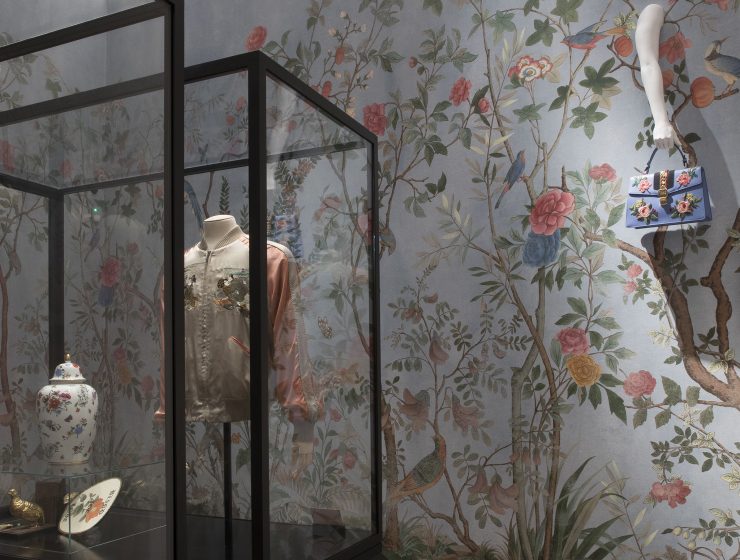Located in the heart of Florence, between the historic Piazza della Signoria and Piazza S. Firenze, Gucci Garden completely overturns the traditional concept of a museum with its dynamic elegance and creative exuberance. Found in a 14th-century building—inside the Palazzo della Mercanzia—that since 2011 has housed the Gucci Museum, Gucci Garden is a new project by creative director Alessandro Michele, curated in collaboration with Maria Luisa Frisa, fashion critic and director of the fashion design and multimedia arts graduate program at IUAV University in Venice.
In the Garden, find a gorgeous and wide display of garments and accessories that reflect the historic collections of Gucci. If that were not enough, the concept is also filled with decorative items and contemporary artworks. On the ground floor of this ancient palace, unwind at Gucci Osteria, a restaurant by Michelin-starred chef Massimo Bottura; browse the luxe bookstore for new coffee table displays; and explore the dazzling and colorful boutique showcasing unique and exclusive pieces designed specifically for the space, all branded Gucci Garden.
Understandable given its name, the gallery’s whole concept is built around the metaphor of a garden, which alludes to the omnipresent theme of nature in the aesthetics of Gucci, as well as the abstract idea of cyclical fluctuations: a continuous beginning and a continuous return. Following this thematic path, Gucci Garden combines the creative evolution of the house with a selection of exquisite items ranging from 1921 to today, all highlighted by installations of contemporary artists related to the brand and its codes. This includes Californian illustrator Jayde Fish, Canadian snowboard champion and street artist Trevor Andrew (also known as Trouble Andrew), and Spanish photographer Coco Capitán.
An itinerary of sorts starts at the stairs, the surrounding walls of which are covered with ironic and ambiguous phrases such as “Common sense is not that common” and “If you’ve seen it all. Close your eyes” by Coco Capitán, who is notable for her childlike calligraphy that records her reflections on society. Then comes the first room, Guccification: a deep meditation on the brand’s iconic Double G logo, which was named after the founder Guccio Gucci. Here, on stage-like platforms, sit dresses and skirts from the 1970s and more street style-inspired items, such a sampling of coats belonging to the 2016 GucciGhost Collection by Michele. On a wall, a mural designed by Trevor Andrew, who contributed to the creation of the GucciGhost items, seemingly hovers around. The dominant piece in the room is the pop version of a Renaissance dress designed by Michele that fully explains the meaning of Guccification: the freedom of expressing oneself beyond the constraints imposed by society.
In the second room, dubbed Paraphernalia, is a tribute to the codes that characterized the creation of Gucci’s identity, such as the use of the clamp, the signature bamboo bag, and the idea of femininity—all viewed by three celebrated creative directors (Frida Giannini, Tom Ford, and Michele) and expressed in three different evening dresses. Cosmorama is the name of the third room on the first floor, designed to explore the concept of travel by exposing a series of suitcases, starting with those designed in the 1930s right up to the most current and contemporary variations. Only recently inaugurated are rooms on the second floor decorated with murals painted by Jayde Fish. There is the Period Room, which hosts a rotating series of installations; currently it is dedicated to Bjork, with all the superbly creative dresses and masks designed by Michele for the Icelandic singer’s “The Gate” music video.
The second floor is also the place where the Cinema da Camera Room is located, with video installations by emerging artists including Zapruder, a group of Italian filmmakers who created a series called Zeus Machine. Continuing the journey leads one to De Rerum Natura, which explores Michele’s passion for animals and nature. Here, a collection of beautifully designed floral dresses, along with several furs, designed by Ford are on display. In addition, there is an opportunity to dwell on the paper drawings by renowned illustrator Vittorio Accornero that adorn Gucci scarves, while the space itself speaks to visitors via the Gucci Tian wallpaper that recalls delicate flowers and plants found in traditional Chinese paintings. This floral path leads to the last room, Ephemera, which traces the history of the maison through historical and contemporary objects. It’s a fitting conclusion to a journey that celebrates the evolution, the eclecticism, and the dynamism of Gucci.
Read more in fashion.
